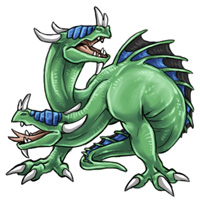Pet Facts



Draklaita Facts
|
More than one Draklaita makes Draklaites.
|
|
A whole bunch of Draklaites make up a Cry.
|
|
Draklaites come from eggs.
|
|
A Draklaita egg takes exactly 7 weeks to hatch.
|
|
Although they appear to be skinny, Draklaita legs are actually extremely strong and help this pet run very fast.
|
|
Draklaites are blind, but their other senses are superb.
|
|
They use ultrasonic waves to "see" their way around, very similar to echolocation.
|
|
They have ears: they are miniature holes behind their horns.
|
|
The first head, the one on the right, contains the brain, first set of ears, canine (cuspid) teeth, and main salivary glands. This makes the creature fit for eating meat.
|
|
The second head contains secondary salivary glands, a second set of ears and flat molars meant for crushing rather than tearing and cutting. This makes the creature fit for eating plants.
|
|
With the help of their three talons, Draklaites are able to leap far distances. This is especially useful when hunting.
|
|
Draklaites are very pack oriented.
|
|
Cries are run by an alpha male and an alpha female; all of the other Draklaites are young underlings.
|
|
Cries typically consist of six Draklaites.
|
|
Draklaites are a species of Misticpet that are believed to have evolved from deep-sea pets. They are mainly predators (although they can eat both meat and vegetation) and have just two legs that are built thinly. However, their legs have strong muscles and tendons which are used for speed and endurance. Each leg ends in three long claws meant for tearing and gripping. They travel in packs and work as a team to get food.
|
|
Because Draklaites have no eyes, their other senses are heightened. Rather than seeing by smell, they see through sound. Their ear canals are very miniscule holes hidden beneath their main horns which are located on the back of the head. Sound reaches the ear and spreads through nodes running to both the brain and the feet. Vibrations can also be absorbed through the soles of their feet and transferred up said nodes. The sound waves and vibrations form outlines and shapes of things (similar to echolocation) and allow the Draklaites to 'see' much better than their potential prey. The nodes do not run through the tail or back.
|
|
A fascinating aspect of Draklaita anatomy is the fact that they have two heads. Their first head, the one on the right, contains the brain, first set of ears, canine (cuspid) teeth, and main salivary glands. The second head contains secondary salivary glands, a second set of ears and flat molars meant for crushing rather than tearing and cutting. The first head is carnivorous and the most used, while the second head is herbivorous and can absorb nutrients from vegetation through it's taste buds.
|
|
The Draklaites also have a very unique method of tracking down prey. Utilizing the three talons on their feet, their tough muscles let them leap through the air to tackle their quarry. If their weight alone does not ground the quarry, the Draklaites will use the horn protruding from their chin to strike their prey until it can no longer stand.
|
|
Rankings in a pack of Draklaites- also known as a Cry- consist of an alpha male and an alpha female. There is no rank for the underlings, but they are included in the group and are highly valued and protected because babies are rare. A Cry often contains about six Draklaites, including the young. Too many traveling together would exhaust their food supply in a matter of months, while a group of normal size has been known to stay in one area for close to a year.
|
|
Draklaites hatch from eggs exactly seven weeks after the eggs are laid. When first born, they do not have the line of spikes on their back, these grow in over the course of their first three weeks. However, the spikes on their upper and lower jaws are present, aiding the Draklaites in their exit from the eggs. The claws on a young Draklaita do not fully develop until they are ten weeks old. Before this time, it will depend upon it's mother to fend for it.
|
Go Back
